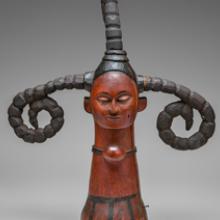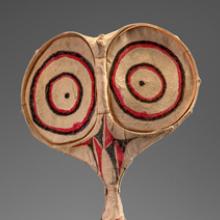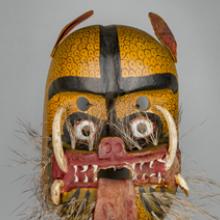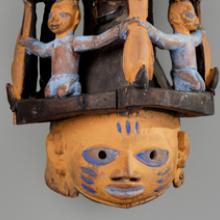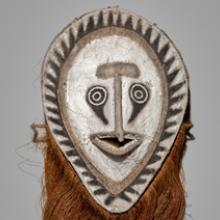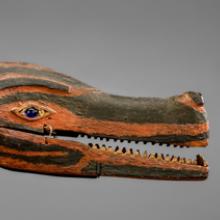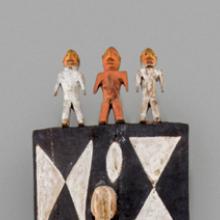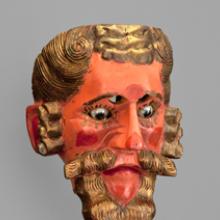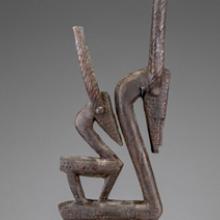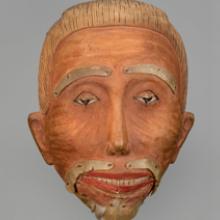International Terminal












Mask c. 1940s–60s
Ibibio
Nigeria, West Africa
wood, pigments
Collection of the Phoebe A. Hearst Museum of Anthropology, UC Berkeley
5–11694
L2010.1801.077a-d
The Ibibio have lived in the Cross River area of modern day Nigeria for several hundred years. Worn during Ibibio masquerades, this crest mask depicts a female beauty with elaborate coils of braided hair. Staged during funerals, initiations of new members, and other events sponsored by secret societies of young men, these dance dramas involve a group of supernatural characters. This piece is worn on top of the head, attached to a basketry cap, and held on by a chinstrap, taking on the appearance of an actual human head when worn by the performer. Draped cloths and other garments cover the face and the rest of the dancer’s body.
Mask before 1898
Yup’ik
Alaska
wood, pigments, sinew, baleen, fish skin
Collection of the Phoebe A. Hearst Museum of Anthropology, UC Berkeley
2–4603
L2010.1801.005
In southwestern Alaska, in particular, carvers crafted a staggering number of imaginative masks, many abstract, other combining animal and human features. Carvers made masks that represented important helping spirits (tuunrat) or animal spirits (yuit) encountered in a vision or dream. Carvers finished their masks with a variety of embellishments including feathers, grass, caribou hair, animal fur, willow root, dyed pieces of dried seal intestine, beads, and shells. Masks might consist of a dozen or more parts attached either directly to the body of the mask or adhered to an encircling ring.
Mask before 1969
Baining
Gazelle Peninsula, New Britain, Melanesia
bark cloth, wood, pigments
Collection of the Phoebe A. Hearst Museum of Anthropology, UC Berkeley
11–40748
L2010.1801.095
The Baining people use this mask in a night dance, also referred to as the snake dance. In spectacular performances, men bravely dance around and through a fire in cleared village dance grounds. Night dances were originally concerned with male associations and appeasing various bush-spirits. Currently, they are used in contemporary ceremonies such as the celebration of Papua New Guinea’s Independence Day as well as being performed for tourists.
Mask before 1944
Guerrero, Mexico
wood, paint, leather, boar tusk, agave spine
Collection of the Phoebe A. Hearst Museum of Anthropology, UC Berkeley
3–22903
L2010.1801.051
This mask was used for the dance of the Tecuanes (“human-eaters” or Tlacololeros “farmers of slash-and-burn fields”). The dance focuses on the hunting and killing of the Jaguar character who harasses the local farmers. The Tlacololero Dance also involves much humorous commentary on village life before the Jaguar is found. Olinalá is a great center for lacquer production, so it is not surprising that the mask is lacquered and decorated with tusks and hair.
Mask 1890s
Yup’ik
Lower Yukon, Alaska
wood, pigments, baleen, seal hide
Collection of the Phoebe A. Hearst Museum of Anthropology, UC Berkeley
2–5854
L2010.1801.010
Masked dancing and storytelling formed an integral part of Yup’ik ceremonial life.
Many masked performances took place inside the communal men’s house during festivals. Ceremonies focused on the interactions between humans, animals, and the spirit world. Shamans played a pivotal role in the creation of masks and the organization of performances. With his bow (and arrow), the shaman—who is seen in the skeletal form necessary for supernatural voyages—has overcome the sea goddess.
Gelede mask c. 1930–40
Yoruba
Nigeria, West Africa
wood, pigments
Collection of the Phoebe A. Hearst Museum of Anthropology, UC Berkeley
5–16181
L2010.1801.075
A variety of masquerades aid Yoruba communities in communicating with the spirit world, while entertaining the living. Gelede festivals celebrate women and motherhood. These festivals are meant to honor the power and authority of females and ensure fertility. Gelede performances take place each year at the beginning of the agricultural season. Men play the role of women, wearing elaborate costumes and masks similar to those of an Egungun masquerade, which honors ancestors. The Gelede festival entails a sequence of dances, which begins with a series of nighttime performances and rituals known as Efe. On the day of the Gelede performance, a number of masquerades take place, which are performed in order of age, the youngest appearing first. Egungun and other Yoruba maskers hide their identities and speak in disguised voices. The Gelede masker, however, may unmask in public and speaks in a natural voice.
Mask before 1960
probably Elema people
Orokolo Village, New Guinea, Melanesia
barkcloth, pigments, lime, fiber
Collection of the Phoebe A. Hearst Museum of Anthropology, UC Berkeley
11–37414
L2010.1801.097
The Elema people of the Papuan Gulf region of New Guinea once participated in a cycle of masked rituals that revered water spirits known as ma hevehe. The most significant mask used in this ritual was the enormous mask known as the hevehe. Counterbalancing this sacred mask was the eharo, literally “dance head” or “dance mask,” a brightly painted conical-shaped mask made from bark cloth stretched over a framework of cane. These masks, though part of an important ceremonial cycle, served the purpose of entertaining spectators. Most eharo depicted aulari—the ancestral spirits associated with individual familial clans. Other eharo portrayed spirits and characters inspired by local oral tradition.
Wolf mask before 1889
Makah
Neah Bay, Washington
wood, pigments, glass, spruce root
Collection of the Phoebe A. Hearst Museum of Anthropology, UC Berkeley
2–10045
L2010.1801.018
Common mask forms made by Northwest Coast carvers included depictions of animals such as eagles, bears, ravens, and wolves. Craftsmen enhanced their works with bold paint colors that accentuated facial features. They also painted a variety of designs onto masks, which helped to identify the spirit or being personified by the mask. Masks were used during ceremonies to contact, commemorate, and appease the spirit world. Masked performances often took place during potlatches, great feasts that showcased the wealth and power of chiefs.
Plank mask 1900s
probably Bwa
Burkina Faso, West Africa
wood, pigments
Collection of the Phoebe A. Hearst Museum of Anthropology, UC Berkeley
5–16207
L2010.1801.069
The Bwa people live in northwestern Burkina Faso and Mali. The abstract plank masks they create represent supernatural forces and spirits. The masks are typically painted in black, white, and red with lively geometric patterns. Each one has a meaning that conveys spiritual and moral beliefs. The most common motifs are an X or cross form; checkerboards, crescents, zizag lines, triangles, and circles. The interpretation of each motif varies depending on the person’s age and level of knowledge.
Alvarado mask before 1950
Chichicastenango, Guatemala
wood, paint
Collection of the Phoebe A. Hearst Museum of Anthropology, UC Berkeley
3–15598
L2010.1801.033
The Dance of the Conquest tells the tale of Pedro de Alvarado’s 1524 defeat of the indigenous Guatemalans. Pedro de Alvarado was born in Badajoz, Spain, in 1485. He died in battle in Mexico in 1541. After Alvarado helped Hernan Cortéz conquer Mexico in 1521, the Spanish sent him to seize Guatemala. The performance features Alvarado’s combat against the Mayan chief Tecún Umán. Legend has it that during the battle, Tecún killed Alvarado’s horse and Alvarado fell to the ground. Tecún believed that Alvarado was also dead. As Tecún rejoiced, Alvarado rose and killed him with a lance.
Antelope headdress c. 1950s–60s
Bamana
Mali, Guinea, or Senegal, West Africa
wood, pigments
Collection of the Phoebe A. Hearst Museum of Anthropology, UC Berkeley
5–8590
L2010.1801.092
The Bamana antelope headdress is one of the most widely known and collected African mask types. Although each specimen is unique, male antelopes are typically carved with rows of openwork, zigzag patterns and gracefully curved horns. Female antelopes, on the other hand, carry baby antelopes on their backs and usually have straight horns. The crest masks are worn on top of the head, the face itself hidden by a raffia costume. Members of the Ci-wara initiation society always perform with these headdresses in pairs, with one female and one male. Performances take place during agricultural competitions, anniversary celebrations, and other festivals.
Mask, old man c. 1870
Attributed to Simeon Stilthda (c. 1799–1883)
Haida
Queen Charlotte Islands, British Columbia
wood, pigments, seal fur
Collection of the Phoebe A. Hearst Museum of Anthropology, UC Berkeley
2–15550
L2010.1801.023
Most Haida masks, like this one, depict humans or humanoid spirits in a naturalistic style. The facial hair on this mask is represented by strips of fur, most of which is now gone, and the eyelids are made of hide. Male masks often feature wrinkles on the face and moveable lips, brows, and eyes
